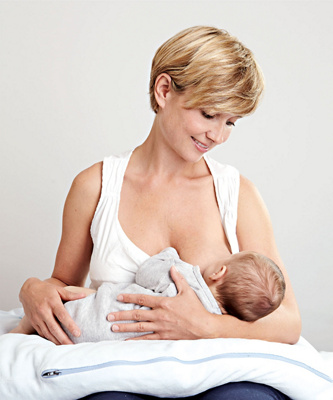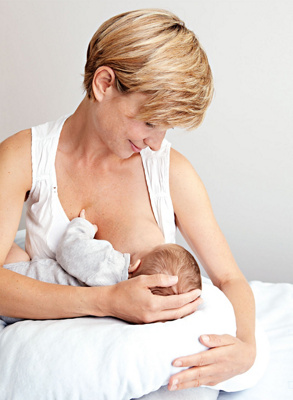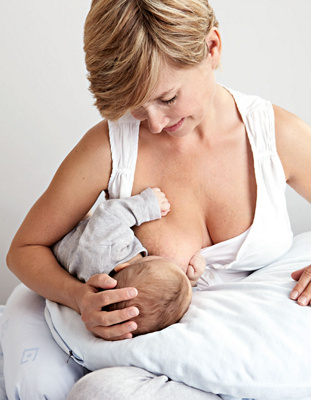Which breastfeeding position is the right one for mother and baby? Anna-Tina Weber-Tramèr, Midwife at Hirslanden Klinik Im Park, explains the 7 most common breastfeeding positions and provides tips on what you should be aware of while breastfeeding.
Breastfeeding is the best form of nutrition for babies. Breast milk adjusts to the changing needs of growing babies perfectly. Breastfeeding can initially be a challenge for mother and child. Midwives and breastfeeding counsellors can provide support in this phase of life.
Basic information on breastfeeding positions
There are different ways to hold your baby when you are breastfeeding. Essentially, you should know the different options so that you can try them out to see which position is most comfortable or practical at which time. It is also important to know which breastfeeding positions may be helpful or are recommended in certain situations or if you have problems. A basic distinction is made between breastfeeding in a reclining position and in a seated position.
Goal
It is very important that you feel comfortable while breastfeeding. Make sure that your arms are in a relaxed position. Use supportive tools such as a pillow, breastfeeding cushion, foot support and armchair, etc. where needed. You and your baby should feel comfortable while breastfeeding. The following is important for all breastfeeding positions: Bring your baby to your breast and not the other way around. The goal is to correctly empty the breast and not place any strain on your nipples.
Preparing for breastfeeding
- Make sure you have everything you need within reach before you start breastfeeding; e.g. pillow, drink, magazine, etc.
- Ensure that you and your baby are sitting or lying comfortably.
- When you start breastfeeding, check that your baby has latched on to your breast correctly.
- Make sure that you drink enough fluid while you are breastfeeding (at least 2 litres per day). Further information: “How does mum eat right while she is breastfeeding?”
- Alternating breastfeeding positions can prevent sore nipples or a milk blockage.
- Contact your midwife or breastfeeding consultant if you have any queries or problems. If you have problems, it is important to seek help early; e.g. if breastfeeding is painful, you have sore nipples or a milk blockage, etc.
Breastfeeding while lying down
Laid-back breastfeeding position or reclined position
This position is also known as the breast crawl. It is sometimes used directly after birth to breastfeed for the first time, when the baby is placed naked on his mother’s upper body. The laid-back breastfeeding position is sometimes used by women with large breasts or a strong let-down reflex*.
*A strong let-down reflex causes the breast milk to flow very quickly and strongly – this can be reduced in the laid-back position.
Side-lying hold
Mum and baby both lie on their side closely facing each other, tummy to tummy. The side-lying hold is a very relaxed position that is often used when breastfeeding during the night. Breastfeeding in the side-lying position is also highly recommended in the first few days after the birth to protect the pelvic floor.

Breastfeeding while seated
Cradle hold
This is the traditional position that spontaneously comes to mind when people think of breastfeeding. Mum sits upright, while her baby lies on his side. His head and neck lie on the forearm of the side where his mother plans to breastfeed; his body lies close to hers, tummy to tummy. In this position, it is important that his mother’s arm is well supported on a pillow or armrest so that her shoulder and arm are relaxed. The baby’s mouth is at the same height as his mother’s nipple. The baby’s ear, shoulder and back all form one line.

Cross-cradle hold
This position is ideal for everyone, but particularly for premature babies or women with large breasts. The cross-cradle hold is similar to the cradle hold. In contrast to the latter, the baby does not lie on the forearm of the side where the mother plans to breastfeed, but rather on a pillow. The mother supports her child with her opposite arm/hand at the back of his head and on his back. If necessary, she can offer her breast in the C-position (with her thumb on one side, and four fingers on the other).

Clutch hold
The clutch hold is also known as the football hold or the clutch grip. This position is good to empty the outer side of the breast (if there is a milk blockage in the outer side of the breast). It also protects any caesarean wounds. The baby lies side on under his mother’s forearm, nestled closely into the side of her body. The baby’s feet point backwards, while his head points towards his mother’s breast. The mother has a good view of her child’s face and can support him on the head or back where required. A breastfeeding pillow is recommended for this position as well.

Double rugby ball hold
The double rugby ball hold / double clutch is a great breastfeeding position for twins as you can feed them in tandem while having your hands relatively free. The pressure on your stomach is minimised as both children lie side on to you. This breastfeeding position is also ideal after a caesarean.
Upright breastfeeding position
In this position the baby rides on his mother’s thigh or hip with an upright spine and head. If the baby is a newborn, his back and head must be supported. This position is generally used for older infants who can already sit upright by themselves.
Summary
Every mum and baby are unique and should find the most suitable methods or positions for them. Important: Alternating positions can reduce the likelihood of milk blockage as different areas of the breast are emptied depending on the position. Nipple soreness can also be alleviated by breastfeeding in different positions.
This list relates to the most common breastfeeding positions and is not complete. Contact your midwife or breastfeeding consultant for information on further positions and if you have questions or problems.
About the author

